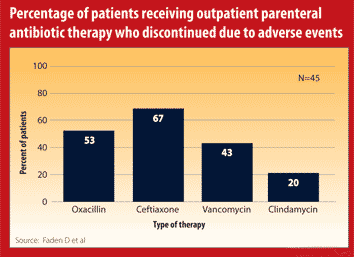OPAT discontinued in many pediatric patients due to adverse events
Adverse drug events have been reported in many children receiving outpatient parenteral antibiotic therapy, often leading to discontinuation of the antibiotic.
In an effort to determine which antibiotics are most commonly associated with an adverse event, researchers from the department of pediatrics at The State University of New York, Buffalo School of Medicine and Biomedical Sciences, and Women and Children’s Hospital of Buffalo reviewed medical records of children who had received this type of therapy for osteomyelitis between 1986 and 2005.
The researchers identified 45 children who received OPAT. There were 26 boys and 19 girls, ranging in age from 5 months to 20 years. The researchers said Staphylococcus aureus caused most of the cases of osteomyelitis, followed by Pseudomonas aeruginosa, Escherichia coli, Enterobacta cloacae, Serratia marcesens and Streptococcus pneumoniae.

Half of the antibiotic courses were associated with an adverse drug event, and 32% of those courses were discontinued because of an adverse event. The researchers said the most commonly identified adverse event was leukopenia, followed by hepatitis and rash.
The researchers said that vancomycin was associated with the highest rate of adverse events at 85.7%, but ceftriaxone was associated with the highest discontinuation rate at 66.7%. About half of the oxacillin courses had to be discontinued because of an adverse drug event.
PIDJ. 2009; 28: 539-541.


Drs. Dara and Howard Faden touched on an important issue when examining to what extent children with prolonged outpatient parenteral antibiotic (for osteomyelitis) discontinue the treatment due to adverse events. The results were astonishing. Every second child developed symptoms or signs interpreted as an adverse drug event (ADE), and one-third discontinued the primary agent. Among the 82 courses analyzed, the three most common ADEs were leukopenia, hepatitis and rash.
The two overwhelmingly most common antimicrobials used were clindamycin (25 courses) and oxacillin (17) whose mean duration was 4.5 and 3.4 weeks, respectively. Eleven ADEs were linked to clindamycin and 13 to oxacillin. All six antibiotics except cefazolin caused ADE, but the discontinuation rate was highest for ceftriaxone (67%), followed by oxacillin in 53% and vancomycin in 43%; for clindamycin it was 20%.
Although we do not know exactly whether the ADEs of the same antimicrobial differ much according to the route (parenteral/oral) used, I raise two questions: Do we need these long courses even in osteomyelitis, and why is parenteral administration used for agents such as the first-generation cephalosporins and clindamycin, which absorb almost entirely, penetrate the tissues sufficiently, and oral administration is very well tolerated by children? Our own experience deriving from a large prospective randomized trial (CID. 2009;48:1201) shows that around a 10-day course of either of these agents suffices for most cases of septic arthritis.
For acute osteomyelitis, a three-week course is usually enough (data submitted). Importantly, only the first two to four days were administered IV, and personally I doubt if even this short parenteral phase is needed. However, large doses (clindamycin: 40 mg/kg/day divided in four, first-generation cephalosporin: 150 mg/kg/day divided in four) are likely pivotal. Shortening unnecessary medication and preferring the oral route are two means with which I think we could diminish the frequency of ADEs.
This said, let us keep it clear in mind that exceptions always prevail in clinical medicine. We, however, should not extend the experience from those difficult-to-treat patients to the routine practice.
– Heikki Peltola, MD
Infectious Diseases in Children Editorial Board
